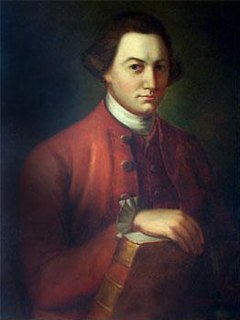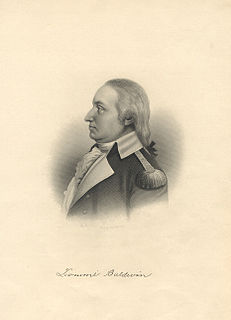
Benjamin Williams was the 11th and 14th Governor of the U.S. state of North Carolina, from 1799 to 1802 and from 1807 to 1808. He was the first of two North Carolina Governors since the American Revolution to serve nonconsecutive terms.
Nathaniel Folsom was an American merchant and statesman.

Nathaniel Ramsey was an American lawyer and soldier from Cecil County, Maryland. Ramsey fought in the Revolutionary War, and was a member of the Congress of the Confederation.
John Haslet was an American Presbyterian clergyman and soldier from Milford, in Kent County, Delaware. He was a veteran of the French and Indian War and an officer of the Continental Army in the American Revolution, serving as the first Colonel of the 1st Delaware Regiment. He was killed in action at the Battle of Princeton.
Joseph Cilley was a New Hampshire state senator and general.
William Maxwell was an Ulster-born brigadier general in the Continental Army during the American Revolutionary War.

The Battle of Long Island was a decisive British victory early in the American Revolutionary War over American forces under the command of Major General George Washington, and the opening battle in a successful British campaign to gain control of New York City in 1776. The Americans had lined New York's harbor with various levels of entrenchment and fortification, which were defended by an array of Continental Army forces and militia companies from New York and nearby states. After the British made an unopposed landing on Long Island in mid-August, Washington reinforced forward positions in the hills of central Brooklyn.
John Nixon was an American brigadier general in the Continental Army during the American Revolutionary War.
Robert Lawson was an officer from Virginia in the American Revolutionary War.

The Battle of Trenton was fought on December 26, 1776, during the American Revolutionary War campaign for New Jersey. In a surprise attack, the Continental Army led by George Washington attacked the winter quarters of a brigade composed primarily of German troops from Hesse-Kassel in Trenton, New Jersey. The Hessian brigade was under the command of Colonel Johann Rall; he died of wounds sustained in the battle, and about two thirds of his men were taken prisoner. It was the first major victory after a long string of defeats that had resulted in the loss of New York City, and was a significant boost to American morale. It was followed by two more American victories, first in a second battle at Trenton on January 2, 1777, and then on January 3 at Princeton.
Captain James Johnston was a soldier from Tryon County, North Carolina in the American Revolution and a member of the North Carolina Provincial Congress.
John Mott was a Captain in the 1st Hunterdon Regiment of the New Jersey militia during the American Revolutionary War. He served as a guide to General George Washington and the Continental Army during their march down along the Delaware River prior to the Battle of Trenton.
Daniel Hitchcock was born in Massachusetts and graduated from Yale University. He moved to Providence, Rhode Island where he became an attorney and was suspected by the authorities of involvement in the Gaspee Affair. At the start of the American Revolutionary War he formed Hitchcock's Regiment of infantry in the Rhode Island Army of Observation. He was first appointed lieutenant colonel in command of the regiment when it marched to serve in the Siege of Boston in 1775. His regiment was renamed the 11th Continental Regiment during 1776. That year, he led his troops at Long Island, Harlem Heights, and White Plains.

David Forman was born in Monmouth County, New Jersey of parents Joseph Forman and Elizabeth Lee. His father was a wealthy shipowner and he was educated at Princeton. At the start of the American Revolutionary War he rallied to the patriot cause and was appointed lieutenant colonel of a New Jersey state regiment. When his commander assumed command of the brigade, he was promoted colonel of the regiment during the New York and New Jersey Campaign in 1776. At the time of the battles of Trenton and Princeton Forman's regiment waged a merciless war against the American Loyalists of Monmouth County. Then and later he became known as "Devil David" for his zeal in suppressing the local Tories. In January 1777, the Continental Congress authorized him to raise Forman's Additional Continental Regiment with the rank of colonel in the Continental Army.

The 26th Continental Regiment was an infantry unit of the Massachusetts Line during the American Revolutionary War. Gerrish's Regiment was raised in the early days of the war, and the regiment underwent name changes as the Continental Army was reorganized in 1776 and 1777. From 1777 onward, the unit was known as the 9th Massachusetts Regiment.
The 19th Connecticut Regiment was a military regiment in the American Revolutionary War. It was formed in 1774 by an act of the Connecticut General Assembly and was authorized 11 companies of volunteers from Enfield, East Windsor, Bolton, and the part of Hartford on the East side of the Connecticut river of Hartford County, Connecticut. The rolls of eight of those companies survive. While General George Washington was reorganizing the Continental Army from December 1775 through February 1776, during the Siege of Boston, Connecticut sent three regiments under Colonels James Wadsworth, Erastus Wolcott, and John Douglass. These regiments reached Boston in late January 1776 and remained for approximately six weeks.
The New Bern District Brigade was an administrative division of the North Carolina militia during the American Revolutionary War (1776–1783). This unit was established by the North Carolina Provincial Congress on May 4, 1776, and disbanded at the end of the war.











